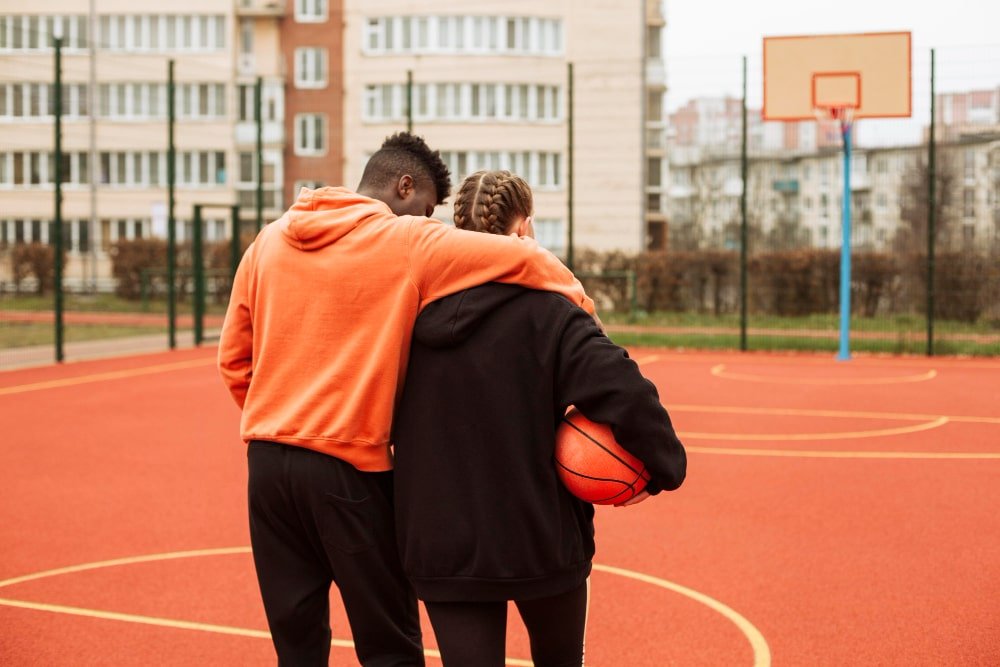Basketball Team Roster: Breaking It Down
It’s basketball season, and basketball teams are gearing up for their first game. How many basketball players are on a team, though? What guidelines apply? How many seasoned basketball players can a team have on its roster at once? Depending on the level you’re playing at, the answers to these questions vary. To help you prepare for your upcoming game, this blog post will go down all of the basketball player and team roster restrictions.
How Many Basketball Players Can Be on the Court?
The number of basketball players allowed to be on the court during a game is five. This includes five basketball players playing defense and five basketball players playing the offense.
On-Court Players

The basketball players on the court are also known as “on-court” basketball players. The substitutes that can come into play if one of these basketball players gets hurt, or are unable to continue playing, are called “off-the-bench” basketball players.
Off-The-Bench Players
Off-the-bench basketball players means you aren’t a member of the starting five, to put it simply.
It simply implies that you won’t be present when play begins on the court. Your coach’s opening lineup is the lineup he intends to use to open the game.
Yet, just because you’re “off the bench” doesn’t mean you shouldn’t start. Coming off the bench, possibly playing the “6th man,” and managing the second team might make you more useful.
Many 6th men have thrived in the role of not being the starter. Manu Ginobili, Lou Williams, and Jamal Crawford spring to mind. Even as a rookie, Ben Gordon received the 6th Man honor.
If you want to start games, you should try to outperform the stringer in front of you each practice. Coaches pay closer attention to practice play than you may expect, however game play is one thing. In practice, the coaches are watching you for little things in addition to the drills. They will see that you are simply trying harder than the other player.
Who is Allowed to Play Basketball?
There are different basketball rules for each level. But in general – if you’re playing high school or college basketball, then it’s pretty standard that only students (and sometimes alumni) at a particular university are allowed to play on their team. However, there are not any restrictions when it comes to professional basketball teams!
Professional Basketball Teams
Professional basketball teams are composed of 15 players. At least eight of these players are typically active for each game. These basketball teams can have up at least three inactive basketball players that will be listed on the team’s roster. But they cannot dress out or sit on the bench during games.
Regular/Association v. Restricted/Unrestricted
Professional basketball teams also have two different types of basketball players: “regular” and “association” (or “affiliated”) basketball players. Association basketball players can be either “restricted” or “unrestricted”. An association player is an individual basketball player that has been temporarily assigned to the roster of a professional basketball team. And he’s given certain rights, duties, and obligations by another basketball team (usually their current one) as part of an affiliation agreement between those two basketball teams.
In NBA terms, the two-way contract was introduced to benefit un-drafted players who do not make the cut in the NBA Draft and enables teams to keep these players “on association” without having to sign to a full-time contract. Players drafted during the first or second-round of an NBA draft are also often signed to two-way contracts. Two-way players are often considered to be the “16th and 17th men” on a roster. Each NBA team is allowed to offer two two-way contracts per season to players with fewer than four years of NBA experience.
Professional Basketball Roster Rules
Many basketball rules govern how basketball players can be affiliated with basketball teams and transferred from one team to another but we won’t go into them here. If you want an in-depth look at the different types of basketball player affiliations and their related professional basketball player transfer restrictions, check out our other blog posts.
College Basketball Teams
College basketball teams include 13 players on the roster but can have up to 14 scholarship athletes listed. These basketball players are usually active for each game, but teams can have up to four inactive basketball players.
In the US and NCAA tournament, according to NCAA rules, a college basketball team can have up to 15 players on its roster, although not all teams carry the maximum number of players. During the game, only 5 players from each team are allowed on the court at any given time.

Walk-On, Regular, and Redshirt Players
Basketball team rosters typically include three different types of basketball players: “walk-on” basketball players, “blue chip” “regular” basketball players, and “redshirt” basketball players.
- Walk-On – This athlete is an individual that has joined a college basketball team without receiving an athletic scholarship. However, they may end up getting one if they play well in the tournament.
- Blue Chip – These basketball players are often high school basketball stars. They are the student-athletes who are considered one of the top prospects that get a lot of attention and hype. Then they ultimately get recruited and join the college basketball team of their choice.
- Regular – These are the basketball players who aren’t highly recruited but still ends up getting a scholarship as a student-athlete in college.
- Redshirt – This refers to a year in which a student-athlete sits out for a playing season, but still maintains their four-year eligibility. While redshirt is not an official National Collegiate Athletic Association (NCAA) term, the practice is commonly adopted by NCAA Division I and Division II athletics programs.
Full or Partial Scholarship
A regular basketball player is given either a “full” or “partial” basketball scholarship to attend the college they’re playing at.
Recognized or Non-Recognized
These two types of basketball players can also be “recognized” or “non-recognized.” A recognized basketball player has met specific academic requirements set by their college for maintaining a full basketball scholarship, while non-recognized basketball players have not.
College Basketball Roster Rules
As previously stated, college basketball teams can only carry 13 total basketball players on their roster at one time. Those are either walk-ons or scholarship basketball players. This means that if there are 14 basketball players on a college basketball team’s active list for a game (including the two non-scholarship athletes), they will be forced to sit out of the game because more than half of them cannot play!
However, this rule does not apply during conference games as long as all participants abide by it and both teams follow suit with how many basketball players they dress out for each game.
Youth Basketball Leagues
Youth basketball leagues typically need only 11 or 12 players for each team with no more than five per gender on a court at one time. This includes both boys’ and girls’ basketball teams. Youth basketball players are typically coached by the basketball team’s older members.
Youth basketball teams have no restrictions on how many basketball players can be in a game at once. However, they must follow the minimum player requirements to compete so that everyone plays an equal amount of time during games.
How Many Substitutes Can Be On A Basketball Team?
Professional Basketball Subs
In professional basketball, there are twelve basketball players in the game at once for each side. These include five on-court basketball players and seven off-the-bench basketball players.

College Basketball Subs
In the college-level basketball team roster, ten students per team take part in a regulation NCAA match-up. That means only five of these athletes can be playing at one time. While the other half sits on the sidelines in case injury occurs or if someone needs to come out of the game due to fouls or bad behavior (for example).
Youth Basketball Subs
The youth league rules might seem confusing when you’re looking through all of them online because some leagues allow six substitutions while others only allow four basketball players to be on the court at once. It can get more confusing when counting basketball players who are sitting out during a match.
The rules for youth basketball teams across America will vary depending on which state they are playing within. The official website of USA Basketball has all of these regulations listed under their Youth Division Regulations page. If it’s still unclear whether there are six substitutions allowed or not, check with your coach before arriving at practice today!
What About Substituting Individual Players?
Basketball matches do include timeouts that basketball teams can use to substitute basketball players. This is when a coach will take out one basketball player and replace them with another so they have an opportunity to rest or get advice from the coaching staff during timeouts.
If there are no substitutions allowed, then this means you either need to play through your fatigue or injuries. Which isn’t always possible depending on the severity of these problems!
Substitutions in most professional leagues
- A substitute shall report to the scorer and position himself in the vicinity of the 8’ Substitution Box located in front of the scorer’s table. He shall inform the scorer whom he is going to replace. The scorer shall sound the horn to indicate a substitution. The horn does not have to be sounded if the substitution occurs between periods or during timeouts.
- A substitute must be ready to enter the game when beckoned. No delays for removal of warm-up clothing will be permitted.
- A substitute must be ready to enter the game when beckoned. No delays for removal of warm-up clothing will be permitted.
- Once a player is in the game, he cannot be removed until the ball is legally touched by a player on the court unless: (1) a personal or technical foul is called, (2) there is a change of possession, (3) a timeout is granted
- If a free throw(s) is awarded, substitutes are only permitted to enter the game prior to the final free throw attempt if the ball will remain in play or following the final free throw attempt if it will not remain in play unless necessitated by disqualification, injury, ejection or any other atypical situation.
Substitutions in Youth Basketball Can Vary
Youth basketball teams across America can substitute basketball players during timeouts even if they have used all of their allotted number of substitutions already! Any basketball player that is subbed in needs to be out by the next whistle though because otherwise, it results in a turnover for both sides.
Injured substitutes do not count as one of the allowed substitutions but must remain within team boundaries or else a technical foul will be called against them and two free throws awarded to the opponent’s side. It also should be noted there are no “in bounds” injuries. Therefore, once your basketball player steps off court, he/she cannot return until play resumes again.
Conclusion
In conclusion, basketball team roster consist of several basketball players that have various roles and responsibilities on the basketball court. These basketball player types can be categorized in many different ways depending on what type of team they play for, their age group, etc.
We hope this blog post has helped you understand basketball teams a little better!
Please leave us feedback in the comments section if there are any other basketball player types or rules that should be included. Thanks so much for reading, basketball fans!








